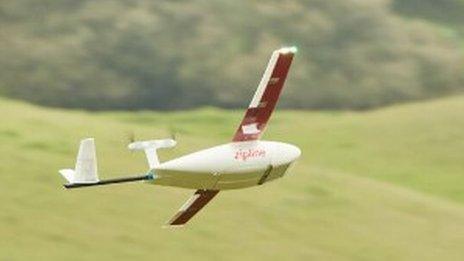The airport that welcomes drone flights
- Published
"It's an attempt to push the boundaries on drone deliveries"
A crowd has gathered on Juma, an island in Tanzania's Lake Victoria, the world's second largest freshwater lake.
The local people are standing behind makeshift nets which cordon off an area where a small group of engineers are consulting laptops and smartphones.
Along with representatives from organisations such as the United Nations children's agency Unicef, the World Food Programme and the World Bank, they are looking up at the skies, waiting for a drone to land.
The drone is being flown within 3km (1.8 miles) of the local airport in Mwanza and, with air traffic control monitoring it, this is a sign of how Africa is leaping ahead in terms of regulation and vision around unmanned flying vehicles.
The flight is part of a conference called the Lake Victoria Challenge (LVC) which aims to make commercial drone flights in East Africa the norm, bringing goods and services to communities such as Juma, which are cut off from the mainland.
The people here are used to seeing aircraft overhead but, aside from the fishermen in their reed boats, few leave the island.
Ferries are infrequent, costly and can be dangerous - a high-profile ferry disaster left more than 200 dead in September 2017 - while speedboats, which take only half an hour to get to the mainland, are prohibitively expensive.
Permission to fly
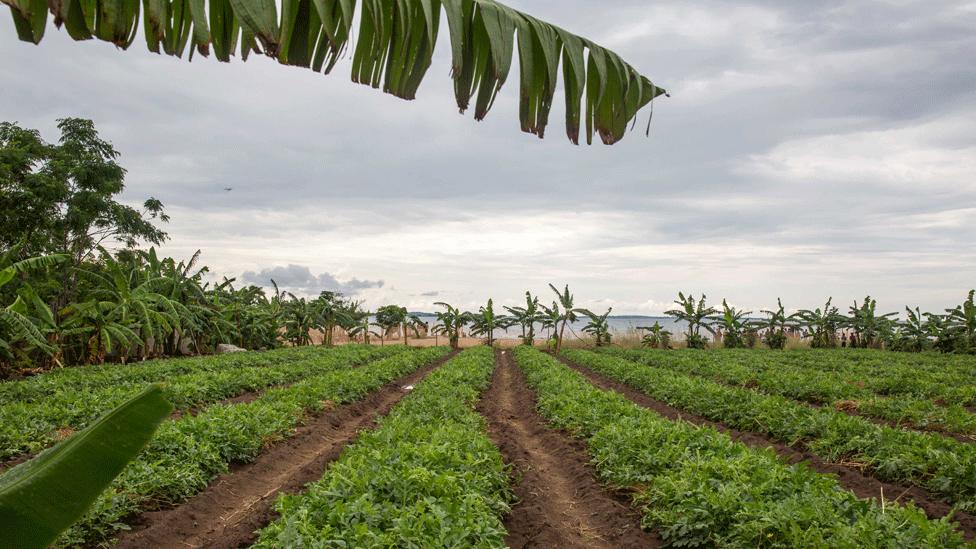
Juma has few natural resources, save for a few basic crops
Fishing is the main livelihood but this too can be dangerous, with hundreds of fishermen from Juma and surrounding islands dying every year in crocodile attacks and drownings.
Virtually no-one learns to swim, and those that do face the dangers of the lake, which is riddled with parasitic worms which can lead to the deadly disease bilharzia.
There is a light buzzing sound as the drone appears in the distance, flanked by local birds fascinated by their hi-tech companion. It lands safely to cheers and clapping from the gathered Westerners and bemused looks from the locals.
Given that Mwanza, where the drone took off, is only 22km away, this may seem an unremarkable event, but testing a system controlled by air traffic control is a daring move.
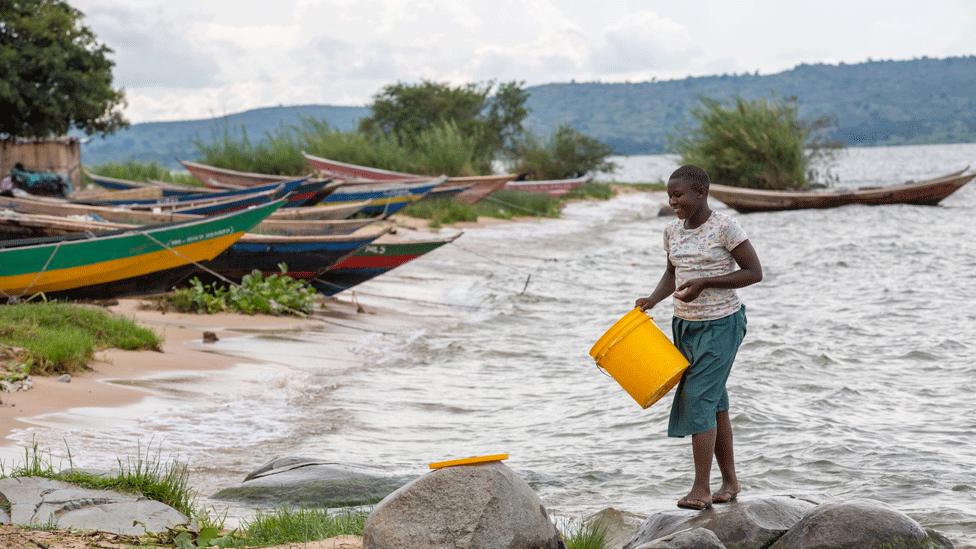
Fishing is the main livelihood but can be deadly, as can the lake water
In the wake of the recent chaos at Gatwick Airport, where a drone grounded hundreds of flights for three days just before Christmas, getting air traffic control involved in drone flights makes a lot of sense.
East Africa is leading the way in terms of forward-thinking and world-leading drone regulation. Rwanda boasts the world's first cargo drone delivery service with Silicon Valley start-up Zipline, which is delivering blood to the country's hospitals thanks to a deal with the government which gave its drones the status of government flights.
And in Malawi, a drone test corridor for humanitarian purposes was launched in 2017 in a partnership between Unicef and the government.

The drone flight to Juma was closely monitored by the engineers at Swiss-based Wingtra, which made it
The Tanzanian civil aviation authority, which gave permission for the drone to fly so close to the airport, wants to make the country drone-friendly while keeping airspace safe.
It has developed a framework that requires potential drone pilots to apply for licences. The individual or group is then vetted by other authorities, including the intelligence services.
And there are strict rules governing flights - the Juma experiment being an exception. Normally, drones cannot fly within 3km of a domestic airport or 5km of an international airport. Drones must not fly above 500ft (152m) or weigh more than 25kg (55lbs).
"We have to have regulation in place to protect aircraft and stop terrorists and other unlawful activity," Hamza Johari, the head of Tanzania's Civil Aviation Authority told the BBC.
Tanzania is also in the process of setting up four civilian radars which will offer surveillance of the whole country's airspace.
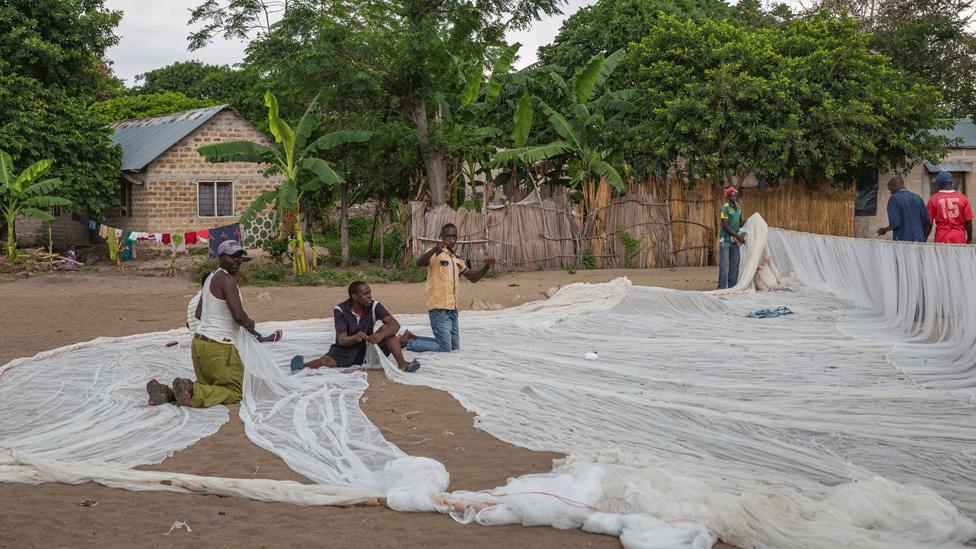
Locals use charity-donated malaria curtains to make fishing nets
The LVC is not just about showing off how drones can fly safely, it also wants to create a sustainable drone industry in Africa, bringing together humanitarian organisations, government and commercial drone companies to do so.
The World Bank - which organised the event - acknowledged the importance of involving the local community in deciding what it needs. On a visit to Juma before the test flight, residents pinpointed medicines, cash and spare parts for the village mill as their priorities.
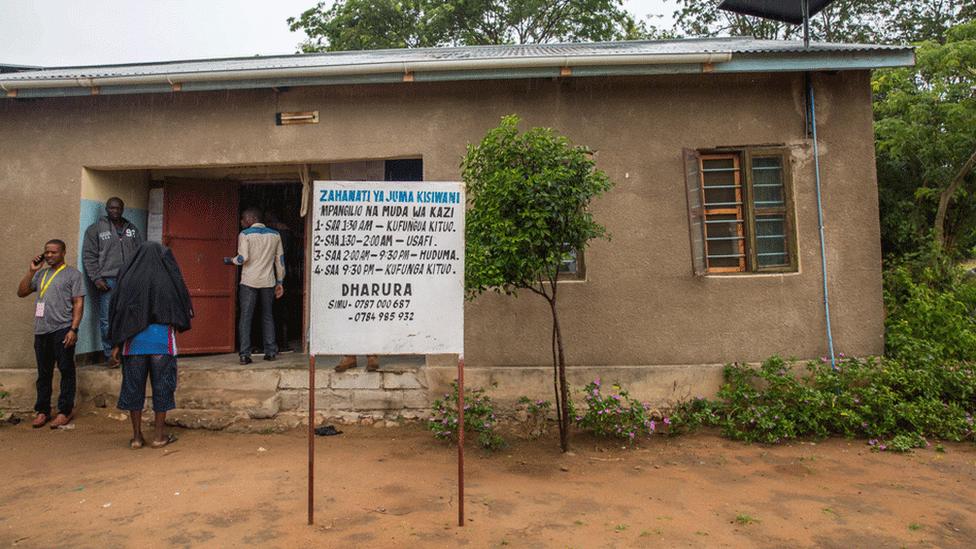
Juma has one clinic but precious little medicine
Although the aim of the LVC is to make a case for commercial drone deliveries, medicines could be the most pressing need.
Juma is lucky because it has a clinic, unlike many of the other nearby islands. However, the building is little more than a cement shed full of leaflets but virtually bereft of actual medicines. There is no antidote for snake bites or anti-rabies vaccine and it takes up to five weeks for such lifesaving supplies to arrive from the mainland.
In an emergency, a patient is taken to the mainland, which takes three hours, and those working in the clinic described medicine by drone as being "lifesaving".
Bamboo drone
Ivan Gayton, head of Tanzania's OpenStreetMap programme, who is acting as a safety co-ordinator at the LVC event, believes what is happening on Juma is similar to the dawn of the computer age.

The flight was successful with what experts described as a "seamless" landing
"We are witnessing the birth of an industry here," he told the BBC. "Like the 1970s when the computer was transitioning from a hobby to something more professional."
Ivan, similarly to all the drone firms taking part in the challenge, is Western, but he is convinced that the drone industry, if it is to be successful in Africa, needs to be run by Africans.
It is one of the reasons that he, along with a Tanzanian colleague at the conference, built a drone out of bamboo, made out of parts that were 3D-printed in Dar es Salaam.
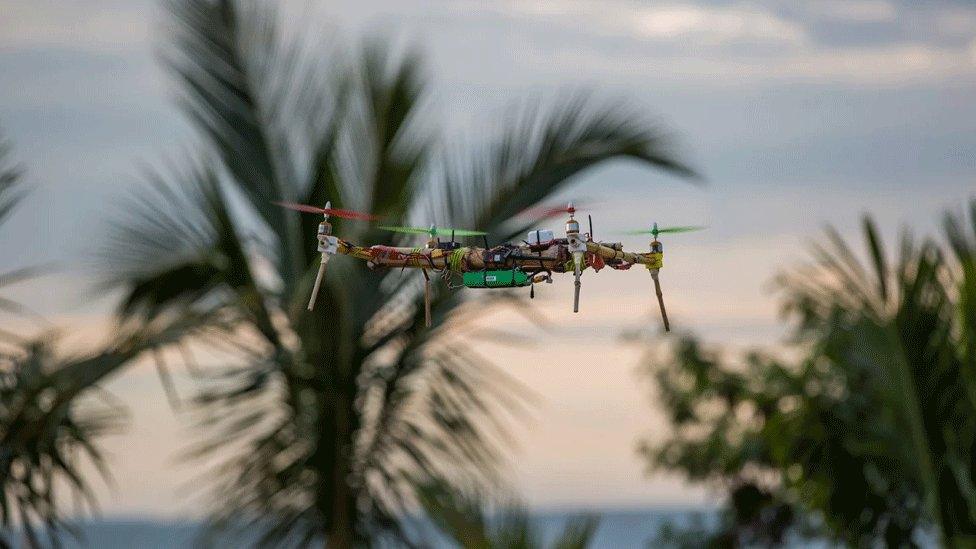
A drone made of bamboo was shown off at LVC
"It is a rickety-looking contraption, but on-board are motors, flight controller, GPS and a lithium polymer battery, so it is quite a sophisticated flight control system and it makes the case that Tanzanians can make, build and fly drones.
"The open source software is so sophisticated that it is possible to do remarkable things with limited resources and local materials."
Zanzibar pilots
Freddy Mbuya, one of the few African drone experts at the conference, agrees.
"There has to be a business case beyond the donor sector. African businesses have to be able to set up and be profitable for drones to work in Africa," he said.
The groundwork for this has already been laid in a mapping project in which he was involved in Zanzibar, which has been lauded around the world.
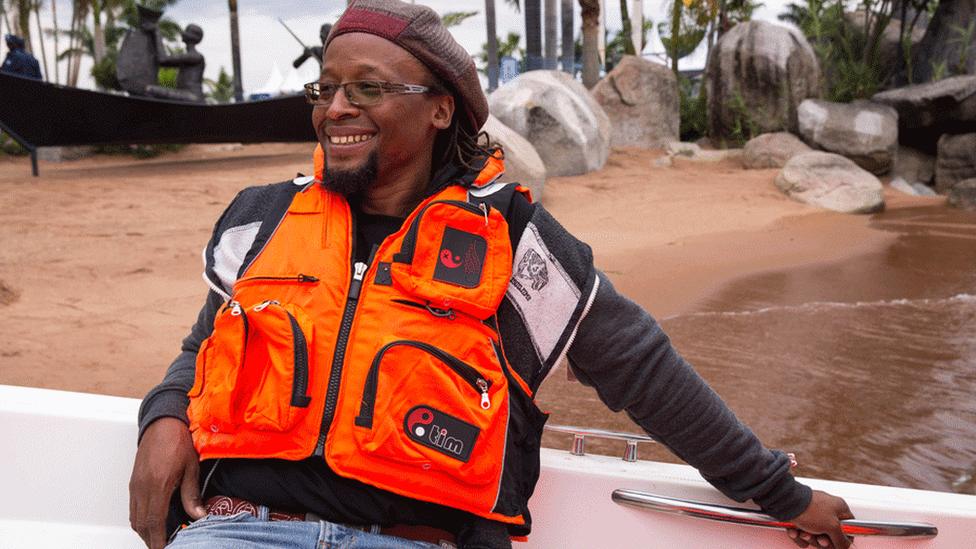
Freddy Mbuya describes himself as 100% Tanzanian, one of the few African drone experts at the LVC
"Zanzibar now has the highest density of young drone pilots anywhere in the world, and some of them have gone on to set up businesses and gain professional contracts."
Mapping, both commercially for mining companies or governments as well as for local communities, is a vital function of drones in Africa, where only 3% of the country is mapped to local scale, he thinks.
When Juma was mapped, the results were shared with the local community.
"They were so excited to see their houses and could immediately see things they could act on, such as trash dumps that could be centralised."
It is important that, as well as creating a community of drone pilots, Africans are equipped to assemble and repair drones, Mr Mbuya thinks.
"If the technology is purchased outside of Africa, it shouldn't have to go back to the originating country to be repaired."
So, while he welcomed tech firms from Europe and the US, he said that any services they offered had to be "mutually beneficial".
"Western tech companies, especially drone companies, come to Tanzania to operate because there is a lot more freedom here. But it is vital that there is the capacity to build things locally. We cannot only use technology as a tool which is made outside of Africa."

Can drones really help those living on Juma?
In 2019, the second LVC will feature drone companies competing in a series of challenges, which are likely to include deliveries of goods to Juma and other islands.
Successful firms will win either cash prizes or contracts with the local Tanzanian government - the details are still being worked out.
And already word is spreading - at the end of this year's conference, attended by a host of local dignitaries, it was announced that Tanzania's post office intends to start using drones.
Light cargo
The technology may be ready - batteries are now more efficient meaning they can fly for longer - but the biggest problem for drones remains the limitations to what they can carry. Currently for most on the market this is no more than 2kg of weight - the equivalent to a paperback book.
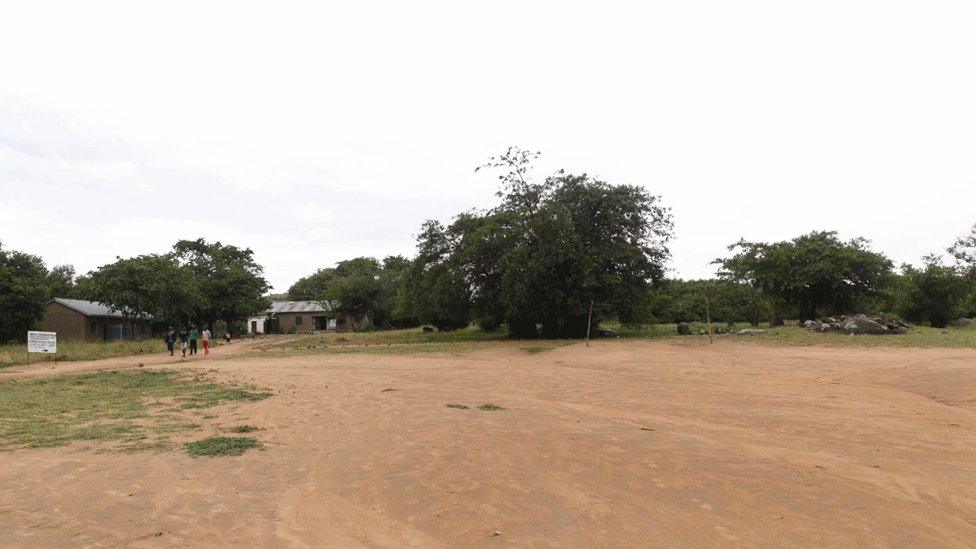
Could this area be used to build a futuristic droneport?
Jonathan Ledgard, the Economist's former Africa correspondent and a drone advocate, thinks that drones will be developed in the next five to seven years that can carry up to 9kg.
"We have got the brain issues with drones sorted and there are advances in vertical take-offs and landings, plus East Africa has made enormous progress on the regulatory side so, if we can get propulsion sorted, we can rapidly scale up," he told the BBC.
There is more to the Juma experiment than only drones, and a patch of land, adjacent to the local school, has been earmarked as a site for a possible droneport - a futuristic airport which would could become the hub of the community.

Prototype drawings for Norman Foster-inspired droneport
That is another of Mr Ledgard's ideas and the building he has in mind, designed with the help of his friend Lord Norman Foster, would be more than just a place for drones to land and take off.
"It would have a civic presence in the community and space for digital fabrication," he said.
"It should be possible to have a droneport in every small town in Africa. By 2035 there could be a high density network of drones, making 20 to 50 flights a day," he said.
And, like others at the LVC, he wants to see drone flights move beyond aid.

Jonathan Ledgard (centre) has a vision for a sky full of drones over Africa
"There is mass take-up of mobile phones in Africa which opens up e-commerce potential. People who want to buy football boots or sunglasses can get them delivered to a droneport, something like an Argos shop," he said.
What Mr Ledgard does not want to see is a "Silicon Valley model where you see marginal use of drones for mining or healthy deliveries" replicated across Africa.
He says this despite the fact that it was him who introduced Zipline to the Rwandan government.
It has become the poster boy for drone deliveries and since October 2016, has flown thousands of kilometres in Rwanda, delivering lifesaving units of blood.
However, Zipline is not without its critics. Those in the African drone community bemoan the fact that it is not sharing either its technology or its route with others, and others question how it got its exclusive deal with the Rwandan government and why it does not divulge its delivery charges.

Zipline's technology is remarkably simple - drones are caught rather than land
Mr Mbuya described the firm as being "outside the rest of the African drone community".
"At LVC all the firms are using the same open hardware and everyone feeds back on that, so that it can be improved," he said.
Defending his company, Zipline's global operation manager, Dan Czerwonka, told the BBC: "We do have a proprietary system, but that was born out of necessity.
"We needed something we could scale up for thousands of flights and there was no existing system that we felt was reliable or safe enough. So yes it is proprietary, but then so is Apple."
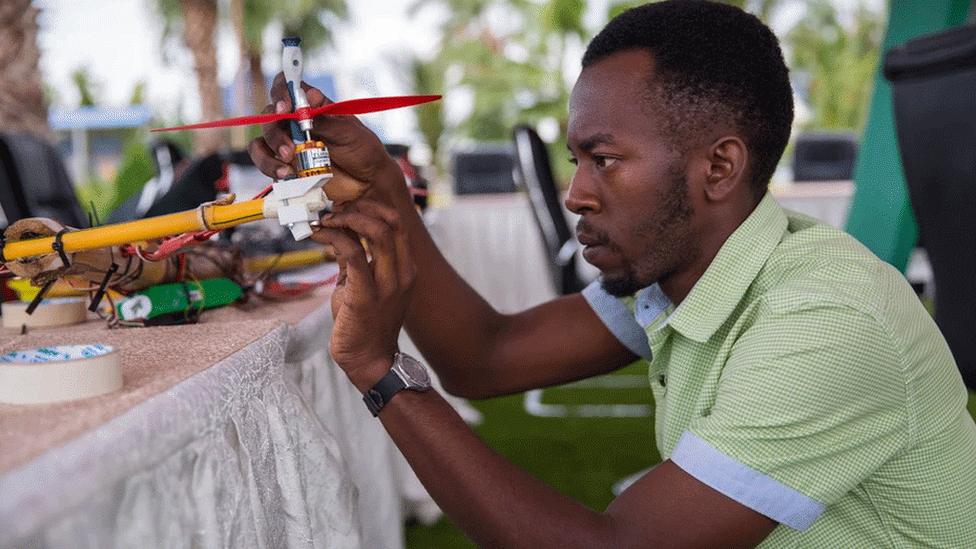
Current drones can only carry very light items
As to accusations that Zipline is using Africa as a test bed with its real ambitions to launch a service in the US, he is ambivalent.
"I don't really think there is a desire for thousands of drones whizzing over people's heads every day, but in rural America there is poor access to health and we want to change that."
The firm is currently in talks with 14 countries around the world to offer new drone services, and move beyond blood delivery.
This includes talks with the Ghanaian government to offer surveillance drones for illegal mining in the country.
Zipline was also due to launch an on demand drone delivery of blood transfusion supplies, emergency vaccines, HIV medications, anti-malarials and other critical medical supplies in Tanzania, with distribution centres due to open this year in four sites around the country.
But so far nothing has happened, despite the CAA granting it licences. Zipline said simply that the "terms aren't yet right", suggesting that the stumbling block could be a financial one.
Leapfrogging roads?
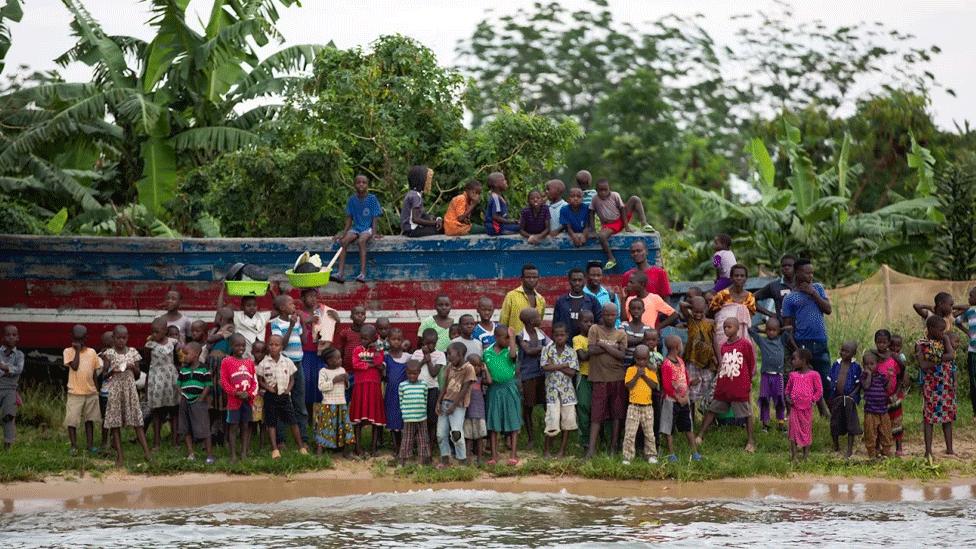
Juma seems a long way away from Jonathan Ledgard's vision of an e-commerce hub
Africa has done an incredible job in introducing new technologies, with mobile phone penetration in sub-Saharan Africa reaching 44% in 2017, with more than 400 million subscribers.
Mobile has effectively leapfrogged fixed-line telecoms infrastructure, leading some to ask whether the same could become true of drones.
Ken Banks has worked on mobile platforms for Africa for the past two decades and he is not convinced.
"I am not sure drones will revolutionise things in the same way as the mobile did, partly because it is harder to move physical things.
"It is not the panacea some people think it will be. Some things need roads. It is easy to get carried away with new technology at the expense of other things. But if a person is ill you can't use a drone to get them from one place to another - you need a road."
- Published3 April 2018
